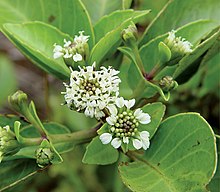
Melicope is a genus of about 240 species of shrubs and trees in the family Rutaceae, occurring from the Hawaiian Islands across the Pacific Ocean to tropical Asia, Australia and New Zealand. Plants in the genus Melicope have simple or trifoliate leaves arranged in opposite pairs, flowers arranged in panicles, with four sepals, four petals and four or eight stamens and fruit composed of up to four follicles.

The Bass Islands consist primarily of Rapa Iti and Marotiri. They are usually considered to be the southernmost of the Austral Islands, although this classification is more one of geographic and political expediency than because of similarities between them and the rest of the Austral Islands. The Bass Islands, lying several degrees outside the tropics, are the southernmost islands in French Polynesia. Culturally, the Bass Islands appear to have been colonized about the same time as Tahiti and the Marquesas, and the culture and language (Rapan) appear to have diverged about the same time as well, indicating that they developed in relative isolation almost from the time of first settlement.

Rapa, also called Rapa Iti, or "Little Rapa", to distinguish it from Easter Island, whose Polynesian name is Rapa Nui, is the largest and only inhabited island of the Bass Islands in French Polynesia. An older name for the island is Oparo. The total land area including offshore islets is 40.5 km2 (15.6 sq mi). As of the 2017 census, Rapa had a population of 507. The island's highest point is at 650 metres (2,130 ft) elevation at Mont Perahu. Its main town is Ahuréi. The inhabitants of Rapa Iti speak their own Polynesian language called the Rapa language.

Coprosma is a genus of flowering plants in the family Rubiaceae. It is found in New Zealand, Hawaiian Islands, Borneo, Java, New Guinea, islands of the Pacific Ocean to Australia and the Juan Fernández Islands.
Oparanthus coriaceus is a species of flowering plant in the family Asteraceae. It is endemic to the island of Rapa Iti in the Tubuai Islands of French Polynesia.
Oparanthus rapensis is a species of flowering plant in the family Asteraceae. It is endemic to the island of Rapa Iti in the Tubuai Islands of French Polynesia.
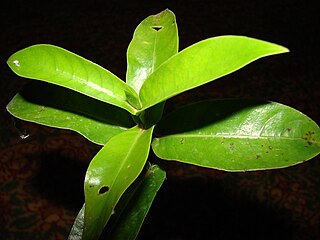
Labordia is a genus of plant in family Loganiaceae. There are 16 species all endemic to Hawaii. It is closely related to Geniostoma
Lepinia is a genus of plant in the family Apocynaceae first described as a genus in 1849. It is native to various islands in the Pacific Ocean.
- Lepinia marquisensisLorence & W.L.Wagner - Fatu Hiva in the Marquesas
- Lepinia ponapensisHosok. - Pohnpei in the Caroline Islands
- Lepinia solomonensisHemsl. - New Guinea, Solomon Islands
- Lepinia taitensis Decne. - Moorea + Tahiti in the Society Islands

Schiedea is a genus of flowering plants in the family Caryophyllaceae. It contains 34 species and is endemic to Hawaii.
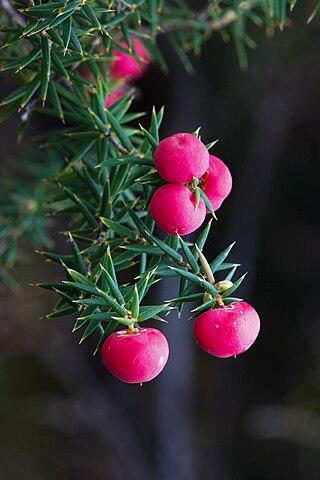
Leptecophylla is a genus of flowering plants in the Epacridaceae family, a subfamily of Ericaceae. The genus is native to southeastern Australia, New Zealand, Papua New Guinea and the Pacific Islands. Some species in this genus were formerly classified within the genera Cyathodes, Lissanthe, Styphelia and Trochocarpa.
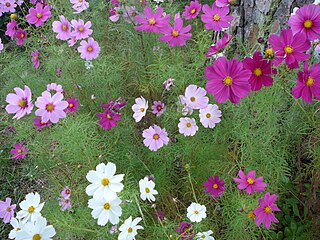
Coreopsideae is a tribe of flowering plants belonging to the Asteroideae subfamily. It includes widely cultivated genera such as Cosmos and Dahlia.

Lipochaeta, common name nehe, is a genus of flowering plants in the family Asteraceae that is endemic to Hawaii.

Melanthera, is a genus of perennial flowering plants in the family Asteraceae, native to North and South America, as well as Africa, Asia and Oceania, including Hawaiʻi.
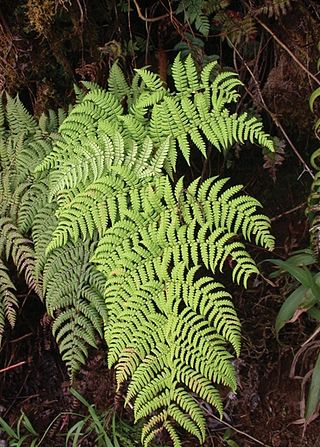
Dryopteris macropholis is a species of fern. It is distributed on the Marquesas Islands.
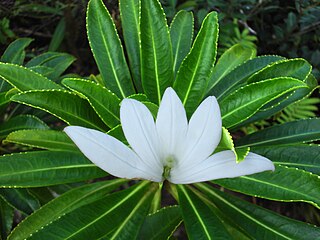
Apetahia was a genus of plants native to various islands of French Polynesia in the South Pacific now considered to be a synonym of Sclerotheca.
- Apetahia longistigmata(F.Br.) E.Wimm - Marquesas
- Apetahia margaretae(F.Br.) E.Wimm. in H.G.A.Engler - Rapa Iti
- Apetahia raiateensisBaill. - Raiatea
- Apetahia seigeliiFlorence - Marquesas

Sclerotheca is a genus of plants native to various islands in the South Pacific. Nine of the ten known species are French Polynesia, the tenth to Rarotonga in the Cook Islands.
- Sclerotheca arborea(G.Forst.) DC - Tahiti
- Sclerotheca forsteriDrake - Moorea, Tahiti
- Sclerotheca jayorumJ.Raynal - Tahiti
- Sclerotheca longistigmataF.Br. - Marquesas
- Sclerotheca margaretaeR.Br. - Rapa
- Sclerotheca magdalenaeJ.Florence - Tahiti
- Sclerotheca oreadesE.Willm. - Tahiti
- Sclerotheca raiateensis(Baill.) Pillon & Florence - Raiatea
- Sclerotheca seigelii(Florence) Pillon & Florence - Marquesas
- Sclerotheca viridifloraCheeseman - Rarotonga
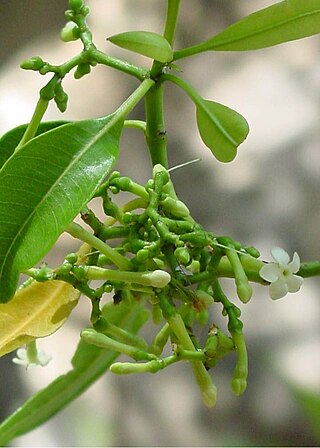
Rauvolfia nukuhivensis is a species of plant in the family Apocynaceae. It is endemic to Nuku Hiva in the Marquesas Islands in French Polynesia.
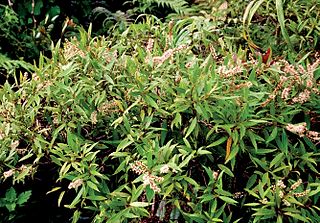
Pterophylla marquesana, formerly known as Weinmannia marquesana, is a species of plant in the family Cunoniaceae. It is a shrub or tree endemic to the Marquesas Islands of French Polynesia.
